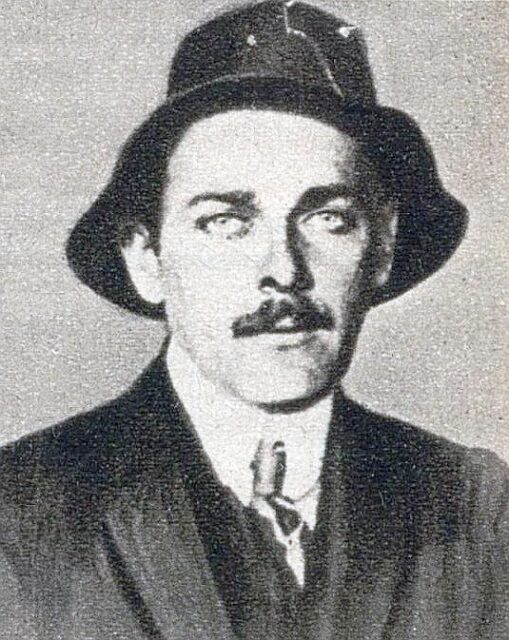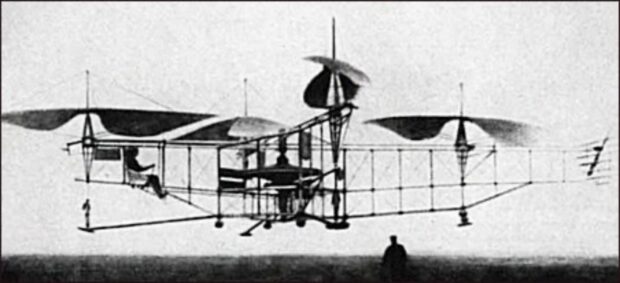The biomechanical facilities of the dragonfly and its agility in flight were a major inspiration to Etienne Oehmichen, the French engineer who set FAI’s very first helicopter record one hundred years ago, on 14 April 1924.
On this date, his Oehmichen 2 quadrocopter rose vertically into the air above Courcelles-lès-Montbéliard, France, and made a journey of 360 m in a straight line. Official observers had just witnessed the very first FAI helicopter record.
The Race Towards Vertical Flight
By the late 19th Century, the practical developments of the industrial era were enabling engineers to carry on where Leonardo da Vinci’s helical air screw design left off. In the wake of post-WWI aeronautical progress, pioneering inventors from Italy, France, Russia, Scotland, the United States, Denmark and Spain clamoured to tame aeronautical instability and propulsion to bring the triumph of vertical flight to their nation.
Assisted by Biology and Photography
Oehmichen, a forward-thinking engineer at Peugeot, was one such pioneer, and he was armed with a special weapon in the race to victory: a camera. His invention of a camera capable of shooting 1,000 frames per second enabled him to capture the precise mechanics of dragonflies in flight. His findings helped him stay ahead of the game.
The Oehmichen 2
His rotorcraft was a cross-shaped construction of metal tubing. Lift was provided by four main two-bladed, counter-rotating rotors: two had a diametre of 6.5m and the other two were longer at 7.5m, and they rotated at 145rpm. Warping controlled the blade pitch. The addition of propellors spinning on the horizontal plane provided lateral stability, with steering controlled by a propellor at the nose. Forward propulsion was provided by a further two propellors.
The First FAI helicopter Records
Oehmichen’s first FAI record was also hailed as a major success in helicopter flight. Following the initial distance of 360m, the aircraft made a second, longer journey of 525m on 17 April 1924. His records were quickly superseded by Argentinian engineer Pateras Pescara, who, on 18 April recorded 736m, in his 2F ‘The Marquis Pateras’ in Issy-les-Moulineaux, near Paris.
Oehmichen went on to complete the first successful closed-circuit helicopter flight on 4 May 1924, flying the Oehmichen 2 around a triangular course of 1km. In September the same year, Oehmichen tested payloads for which he was awarded two further FAI records.
Serafina Ogończyk-Mąkowska, President of the FAI Rotorcraft Commission commented:
“That the FAI registers records – including that of Oehmichen’s first helicopter record one hundred years ago – is crucial for documenting and preserving aviation achievements. FAI plays a significant role in ensuring the credibility and accuracy of aviation records, which helps in advancing the field by recognising outstanding accomplishments and pushing boundaries in aviation technology and performance.”
Oehmichen’s records can be accessed here
Source: FAI Press Release
Biography
 Étienne Edmond Œhmichen (French: 15 October 1884, in Châlons-sur-Marne Châlons-en-Champagne – 10 July 1955, in Paris) was a French engineer and helicopter designer.Œhmichen studied at École Centrale Paris. He patented the first electric stroboscope in 1917,[1] building at the same time a camera capable of shooting 1,000 frames per second.
Étienne Edmond Œhmichen (French: 15 October 1884, in Châlons-sur-Marne Châlons-en-Champagne – 10 July 1955, in Paris) was a French engineer and helicopter designer.Œhmichen studied at École Centrale Paris. He patented the first electric stroboscope in 1917,[1] building at the same time a camera capable of shooting 1,000 frames per second.
Oehmichen N°2 1922
His first successful flight with a helicopter took place on 18 February 1921. On 11 November 1922, he first flew ‘Oehmichen No.2’, an improved helicopter featuring small vertically mounted rotors which rotated in the opposite direction from the large lifting rotors, probably creating the first reliable flying helicopter capable of carrying a person. This work later led to the development of the tail rotor. On 14 April 1924, he broke the existing record for helicopter flight with a flight of 360 m[ and 525 m a few days later, just before being surpassed by Raúl Pateras Pescara. On 4 May 1924, he won a prize of 90,000 French Francs for the first successful closed circuit helicopter flight following a triangular trajectory with a length of approximately one km, a flight which took approximately 7 minutes and 40 seconds. The same year, he made a flight with two passengers.In 1931, Œhmichen invented and tested a type of blimp he called the “Hélicostat”, controlled by four movable propellers, which could hover, take off, and land without ground crew.Œhmichen was also a biologist and studied insect wing function, especially in dragonflies. He worked at the Collège de France in Paris for 30 years until his retirement.

